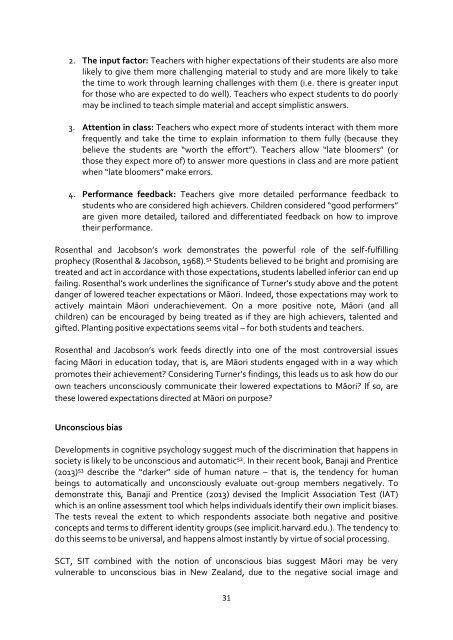UNCONSCIOUS BIAS AND EDUCATION
unconsious-bias-and-education
unconsious-bias-and-education
Create successful ePaper yourself
Turn your PDF publications into a flip-book with our unique Google optimized e-Paper software.
2. The input factor: Teachers with higher expectations of their students are also more<br />
likely to give them more challenging material to study and are more likely to take<br />
the time to work through learning challenges with them (i.e. there is greater input<br />
for those who are expected to do well). Teachers who expect students to do poorly<br />
may be inclined to teach simple material and accept simplistic answers.<br />
3. Attention in class: Teachers who expect more of students interact with them more<br />
frequently and take the time to explain information to them fully (because they<br />
believe the students are “worth the effort”). Teachers allow “late bloomers” (or<br />
those they expect more of) to answer more questions in class and are more patient<br />
when “late bloomers” make errors.<br />
4. Performance feedback: Teachers give more detailed performance feedback to<br />
students who are considered high achievers. Children considered “good performers”<br />
are given more detailed, tailored and differentiated feedback on how to improve<br />
their performance.<br />
Rosenthal and Jacobson’s work demonstrates the powerful role of the self-fulfilling<br />
prophecy (Rosenthal & Jacobson, 1968). 51 Students believed to be bright and promising are<br />
treated and act in accordance with those expectations, students labelled inferior can end up<br />
failing. Rosenthal’s work underlines the significance of Turner’s study above and the potent<br />
danger of lowered teacher expectations or Māori. Indeed, those expectations may work to<br />
actively maintain Māori underachievement. On a more positive note, Māori (and all<br />
children) can be encouraged by being treated as if they are high achievers, talented and<br />
gifted. Planting positive expectations seems vital – for both students and teachers.<br />
Rosenthal and Jacobson’s work feeds directly into one of the most controversial issues<br />
facing Māori in education today, that is, are Māori students engaged with in a way which<br />
promotes their achievement? Considering Turner’s findings, this leads us to ask how do our<br />
own teachers unconsciously communicate their lowered expectations to Māori? If so, are<br />
these lowered expectations directed at Māori on purpose?<br />
Unconscious bias<br />
Developments in cognitive psychology suggest much of the discrimination that happens in<br />
society is likely to be unconscious and automatic 52 . In their recent book, Banaji and Prentice<br />
(2013) 53 describe the “darker” side of human nature – that is, the tendency for human<br />
beings to automatically and unconsciously evaluate out-group members negatively. To<br />
demonstrate this, Banaji and Prentice (2013) devised the Implicit Association Test (IAT)<br />
which is an online assessment tool which helps individuals identify their own implicit biases.<br />
The tests reveal the extent to which respondents associate both negative and positive<br />
concepts and terms to different identity groups (see implicit.harvard.edu.). The tendency to<br />
do this seems to be universal, and happens almost instantly by virtue of social processing.<br />
SCT, SIT combined with the notion of unconscious bias suggest Māori may be very<br />
vulnerable to unconscious bias in New Zealand, due to the negative social image and<br />
31


